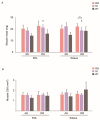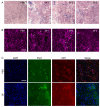Growth Factors Do Not Improve Muscle Function in Young or Adult mdx Mice
- PMID: 35203514
- PMCID: PMC8869250
- DOI: 10.3390/biomedicines10020304
Growth Factors Do Not Improve Muscle Function in Young or Adult mdx Mice
Abstract
Muscular dystrophies constitute a broad group of genetic disorders leading to muscle wasting. We have previously demonstrated that treating a muscular atrophy mouse model with growth factors resulted in increased muscle mass. In the present study, we treated the Duchenne mouse model mdx for 12 weeks with myogenic growth factors peri- and post-onset of muscular degeneration to explore the effects in the oxidative muscle soleus and the glycolytic muscle extensor digitorum longus (EDL). We found no overall beneficial effect in the peri-onset group at the conclusion of the study. In the post-onset group, the functional improvement by means of electrophysiological examinations ex vivo was mostly confined to the soleus. EDL benefitted from the treatment on a molecular level but did not improve functionally. Histopathology revealed signs of inflammation at the end of treatment. In conclusion, the growth factor cocktail failed to improve the mdx on a functional level.
Keywords: DMD; hepatocyte growth factor; leukemia inhibitory factor; mdx; muscular regeneration.
Conflict of interest statement
T.O.K. is a consultant for Lion Therapeutics. J.V. has receive d research and travel support, and/or speaker honoraria from Sanofi/Genzyme and Alexion Pharmaceuticals, and served on advisory boards or as a consultant for Roche, Asklepios Biopharmaceuticals, PTC Therapeutics, Sanofi/Genzyme, Santhera Pharmaceuticals, Sarepta Therapeutics, Novartis Pharma AG, Audentes Therapeutics, and Stealth Biotherapeutics. The remaining authors declare no interests of conflict.
Figures







References
-
- Gatheridge M.A., Kwon J.M., Mendell J.M., Scheuerbrandt G., Moat S.J., Eyskens F., Rockman-Greenberg C., Drousiotou A., Griggs R.C. Identifying Non-Duchenne Muscular Dystrophy-Positive and False Negative Results in Prior Duchenne Muscular Dystrophy Newborn Screening Programs: A Review. JAMA Neurol. 2016;73:111–116. doi: 10.1001/jamaneurol.2015.3537. - DOI - PubMed
Grants and funding
LinkOut - more resources
Full Text Sources

